def putTextRect(img, text, pos, scale=3, thickness=3, colorT=(255, 255, 255),
colorR=(255, 0, 255), font=cv2.FONT_HERSHEY_PLAIN,
offset=10, border=None, colorB=(0, 255, 0)):
"""
Creates Text with Rectangle Background
:param img: Image to put text rect on
:param text: Text inside the rect
:param pos: Starting position of the rect x1,y1
:param scale: Scale of the text
:param thickness: Thickness of the text
:param colorT: Color of the Text
:param colorR: Color of the Rectangle
:param font: Font used. Must be cv2.FONT....
:param offset: Clearance around the text
:param border: Outline around the rect
:param colorB: Color of the outline
:return: image, rect (x1,y1,x2,y2)
"""
ox, oy = pos
(w, h), _ = cv2.getTextSize(text, font, scale, thickness)
x1, y1, x2, y2 = ox - offset, oy + offset, ox + w + offset, oy - h - offset
cv2.rectangle(img, (x1, y1), (x2, y2), colorR, cv2.FILLED)
if border is not None:
cv2.rectangle(img, (x1, y1), (x2, y2), colorB, border)
cv2.putText(img, text, (ox, oy), font, scale, colorT, thickness)
return img, [x1, y2, x2, y1]Y8 Video
Let’s use the same model and code from the previous page that we used on images and run it on video using our own computer CPU.
Use 8l on CPU
Instead of a live camera feed and images we covered on the previous two pages, we will repeat it all with a video using our local CPU first.
Manual BB
If we want to manually create the boxes using the function
from ultralytics import YOLO
import cv2
#import cvzone
import math
import time
#cap = cv2.VideoCapture(0) # For Webcam cannot size for videos
#cap.set(3, 1280)
#cap.set(4, 720)
cap = cv2.VideoCapture("../motorbikes-1.mp4") # For Video
win_name = "Motorbikes-1"
model = YOLO("../Yolo-Weights/yolov8l.pt")
# List of Class names
classNames = ["person", "bicycle", "car", "motorbike", "aeroplane", "bus", "train", "truck", "boat",
"traffic light", "fire hydrant", "stop sign", "parking meter", "bench", "bird", "cat",
"dog", "horse", "sheep", "cow", "elephant", "bear", "zebra", "giraffe", "backpack", "umbrella",
"handbag", "tie", "suitcase", "frisbee", "skis", "snowboard", "sports ball", "kite", "baseball bat",
"baseball glove", "skateboard", "surfboard", "tennis racket", "bottle", "wine glass", "cup",
"fork", "knife", "spoon", "bowl", "banana", "apple", "sandwich", "orange", "broccoli",
"carrot", "hot dog", "pizza", "donut", "cake", "chair", "sofa", "pottedplant", "bed",
"diningtable", "toilet", "tvmonitor", "laptop", "mouse", "remote", "keyboard", "cell phone",
"microwave", "oven", "toaster", "sink", "refrigerator", "book", "clock", "vase", "scissors",
"teddy bear", "hair drier", "toothbrush"
]
while cap.isOpened():
#Read frame from video
success, frame = cap.read()
if success: #if frame is read successfully set the results of the model on the frame
results = model(frame, stream=True)
# Insert Box Extraction section here
for r in results:
boxes = r.boxes
for box in boxes:
x1,y1,x2,y2 = box.xyxy[0]
x1,y1,x2,y2 = int(x1),int(y1),int(x2),int(y2) # convert values to integers
cv2.rectangle(frame, (x1,y1), (x2,y2), (0,255,0), 3)
# we can also use a function from cvzone/utils.py called
#cvzone.cornerRect(img,(x1,y1,w,h))
# extract the confidence level
conf = math.ceil(box.conf[0]*100)/100
# extract class ID
cls = int(box.cls[0])
# display both conf & class ID on frame
putTextRect(frame,f'{conf} {classNames[cls]}',(max(0,x1), max(35,y1)))
# To edit the size & thickness of text use
#putTextRect(frame,f'{classNames[cls]} {conf}',(max(0, x1),max(35,y1)), scale = 2, thickness=1)
cv2.imshow(win_name, frame)
if cv2.waitKey(1) == 27:
break # if user breaks with ESC key
else:
break # if end of video is reached
# Release video capture object and close display window
cap.release()
cv2.destroyAllWindows()- In addition to the video being labeled and shown we also get this output
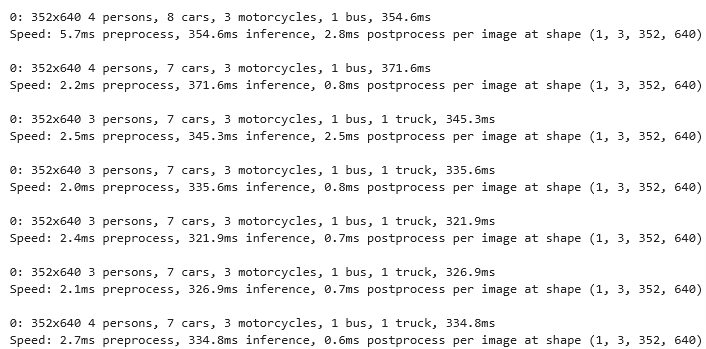
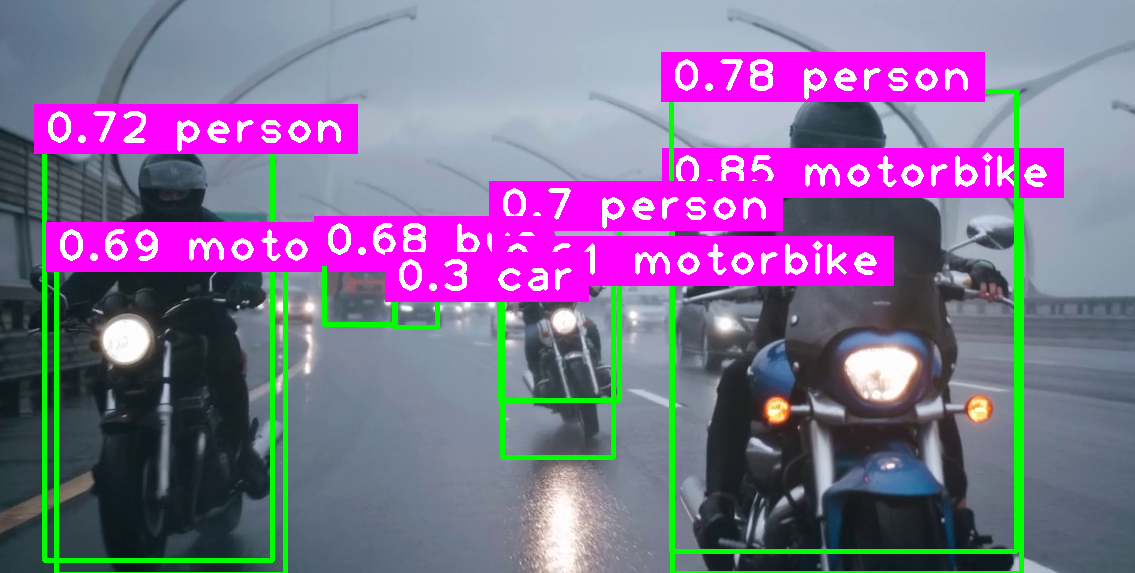
Use 8n on CPU
from ultralytics import YOLO
import cv2
#import cvzone
import math
import time
#cap = cv2.VideoCapture(0) # For Webcam cannot size for videos
#cap.set(3, 1280)
#cap.set(4, 720)
cap = cv2.VideoCapture("../motorbikes-1.mp4") # For Video
win_name = "Motorbikes-1"
model = YOLO("../Yolo-Weights/yolov8n.pt")
# List of Class names
classNames = ["person", "bicycle", "car", "motorbike", "aeroplane", "bus", "train", "truck", "boat",
"traffic light", "fire hydrant", "stop sign", "parking meter", "bench", "bird", "cat",
"dog", "horse", "sheep", "cow", "elephant", "bear", "zebra", "giraffe", "backpack", "umbrella",
"handbag", "tie", "suitcase", "frisbee", "skis", "snowboard", "sports ball", "kite", "baseball bat",
"baseball glove", "skateboard", "surfboard", "tennis racket", "bottle", "wine glass", "cup",
"fork", "knife", "spoon", "bowl", "banana", "apple", "sandwich", "orange", "broccoli",
"carrot", "hot dog", "pizza", "donut", "cake", "chair", "sofa", "pottedplant", "bed",
"diningtable", "toilet", "tvmonitor", "laptop", "mouse", "remote", "keyboard", "cell phone",
"microwave", "oven", "toaster", "sink", "refrigerator", "book", "clock", "vase", "scissors",
"teddy bear", "hair drier", "toothbrush"
]
while cap.isOpened():
#Read frame from video
success, frame = cap.read()
if success: #if frame is read successfully set the results of the model on the frame
results = model(frame, stream=True)
# Insert Box Extraction section here
for r in results:
boxes = r.boxes
for box in boxes:
x1,y1,x2,y2 = box.xyxy[0]
x1,y1,x2,y2 = int(x1),int(y1),int(x2),int(y2) # convert values to integers
cv2.rectangle(frame, (x1,y1), (x2,y2), (0,255,0), 3)
# we can also use a function from cvzone/utils.py called
#cvzone.cornerRect(img,(x1,y1,w,h))
# extract the confidence level
conf = math.ceil(box.conf[0]*100)/100
# extract class ID
cls = int(box.cls[0])
# display both conf & class ID on frame
putTextRect(frame,f'{conf} {classNames[cls]}',(max(0,x1), max(35,y1)))
# To edit the size & thickness of text use
#putTextRect(frame,f'{classNames[cls]} {conf}',(max(0, x1),max(35,y1)), scale = 2, thickness=1)
cv2.imshow(win_name, frame)
if cv2.waitKey(1) == 27:
break # if user breaks with ESC key
else:
break # if end of video is reached
# Release video capture object and close display window
cap.release()
cv2.destroyAllWindows()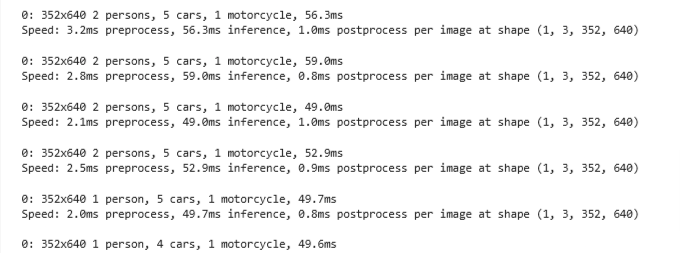
Y8 Built-in
If we use the built-in functions to annotate the boxes, classes and id’s we write it as
from ultralytics import YOLO
import cv2
import math
# Set 0 for the ID of the default camera
#cap = cv2.VideoCapture(0)
cap = cv2.VideoCapture("../motorbikes-1.mp4") # For Video
# Add model to evaluate the video capture
model = YOLO('../Yolo-Weights/yolov8l.pt')
while cap.isOpened():
#Read frame from video
success, frame = cap.read()
if success: #if frame is read successfully set the results of the model on the frame
results = model.track(frame, stream = True, persist = True)
# visusalize the results on the frame
for res in results:
annotated_frame = res.plot()
print(annotated_frame)
# display the annotated frame
cv2.imshow("ShaYaSha", annotated_frame)
if cv2.waitKey(1) == 27:
break # if user breaks with ESC key
else:
break # if end of video is reached
# Release video capture object and close display window
cap.release()
cv2.destroyAllWindows()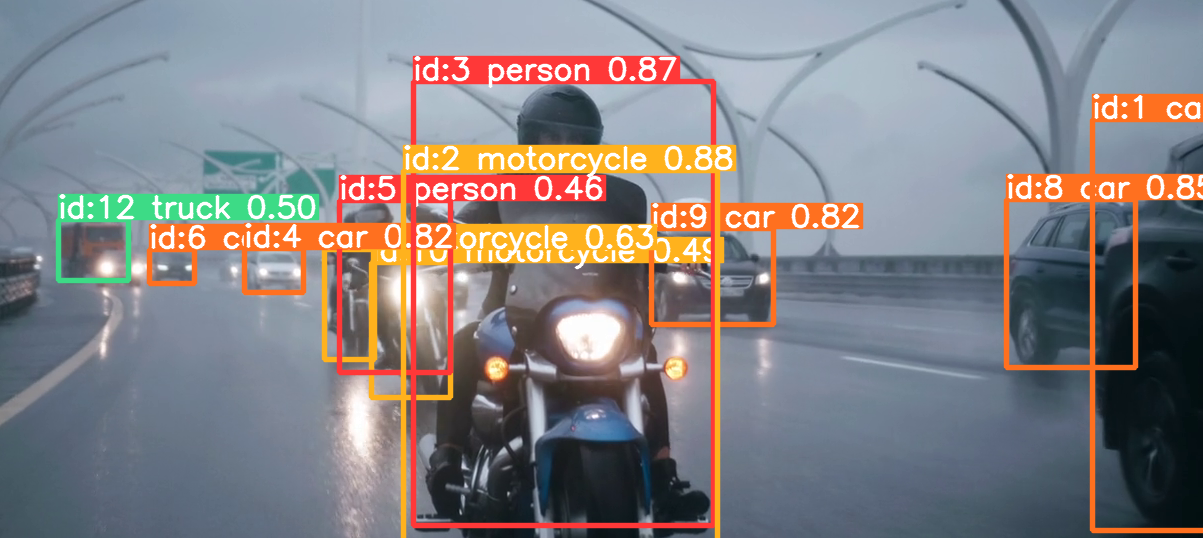
# OUTPUT
0: 352x640 2 persons, 3 cars, 2 motorcycles, 747.6ms
Speed: 4.0ms preprocess, 747.6ms inference, 4.0ms postprocess per image at shape (1, 3, 352, 640)
[[[144 128 108]
[144 128 108]
[144 128 108]
...
[173 156 138]
[173 156 138]
[173 156 138]]
[[144 128 108]
[144 128 108]
[144 128 108]
...
[173 156 138]
[173 156 138]
[173 156 138]]
[[144 128 108]
[144 128 108]
[144 128 108]
...
[173 156 138]
[173 156 138]
[173 156 138]]
...
[[ 61 56 36]
[ 62 57 37]
[ 61 56 36]
...
[ 21 17 5]
[ 21 17 5]
[ 21 17 5]]
[[ 62 57 37]
[ 61 56 36]
[ 61 56 36]
...
[ 19 16 1]
[ 19 16 1]
[ 19 16 1]]
[[ 61 56 36]
[ 61 56 36]
[ 61 56 36]
...
[ 19 16 1]
[ 19 16 1]
[ 19 16 1]]]
0: 352x640 2 persons, 3 cars, 2 motorcycles, 631.3ms
Speed: 3.0ms preprocess, 631.3ms inference, 2.0ms postprocess per image at shape (1, 3, 352, 640)
[[[145 129 109]
[146 130 110]
[146 130 110]
...
# WITHOUT PRINTING THE BOXES
0: 352x640 2 persons, 3 cars, 2 motorcycles, 720.0ms
Speed: 4.0ms preprocess, 720.0ms inference, 2.0ms postprocess per image at shape (1, 3, 352, 640)
0: 352x640 2 persons, 3 cars, 2 motorcycles, 583.2ms
Speed: 3.6ms preprocess, 583.2ms inference, 2.0ms postprocess per image at shape (1, 3, 352, 640)
0: 352x640 2 persons, 5 cars, 3 motorcycles, 669.9ms
Speed: 3.0ms preprocess, 669.9ms inference, 1.0ms postprocess per image at shape (1, 3, 352, 640)
0: 352x640 2 persons, 5 cars, 3 motorcycles, 530.2ms
Speed: 4.0ms preprocess, 530.2ms inference, 2.0ms postprocess per image at shape (1, 3, 352, 640)
0: 352x640 2 persons, 5 cars, 3 motorcycles, 678.5ms
Speed: 3.3ms preprocess, 678.5ms inference, 1.0ms postprocess per image at shape (1, 3, 352, 640)
0: 352x640 2 persons, 5 cars, 3 motorcycles, 671.8ms
Speed: 3.0ms preprocess, 671.8ms inference, 1.0ms postprocess per image at shape (1, 3, 352, 640)
0: 352x640 2 persons, 5 cars, 3 motorcycles, 668.2ms
Speed: 4.0ms preprocess, 668.2ms inference, 1.0ms postprocess per image at shape (1, 3, 352, 640)
0: 352x640 2 persons, 5 cars, 3 motorcycles, 668.5ms
Speed: 5.0ms preprocess, 668.5ms inference, 1.0ms postprocess per image at shape (1, 3, 352, 640)Print Boxes
for r in results:
boxes = r.boxes
for box in boxes:
x1,y1,x2,y2 = box.xyxy[0]
print('x1x2y1y2',x1,y1,x2,y2)
cls = int(box.cls[0])
print('cls -->',cls)
print('box[0] -->',box[0])
print('box.cls -->',box.cls)
print('box.conf -->',box.conf)x1x2y1y2 tensor(11.5496) tensor(150.4709) tensor(551.4695) tensor(479.8398)
cls --> 0
box[0] --> ultralytics.engine.results.Boxes object with attributes:
cls: tensor([0.])
conf: tensor([0.8929])
data: tensor([[ 11.5496, 150.4709, 551.4695, 479.8398, 0.8929, 0.0000]])
id: None
is_track: False
orig_shape: (480, 640)
shape: torch.Size([1, 6])
xywh: tensor([[281.5096, 315.1554, 539.9199, 329.3690]])
xywhn: tensor([[0.4399, 0.6566, 0.8436, 0.6862]])
xyxy: tensor([[ 11.5496, 150.4709, 551.4695, 479.8398]])
xyxyn: tensor([[0.0180, 0.3135, 0.8617, 0.9997]])
box.cls --> tensor([0.])
box.conf --> tensor([0.8929])Video on GPU
Make sure these are installed inside the venv
Torch-directml
I don’t see any difference and in the onnx instance it was much slower. In Linux it wasn’t compatible so my guess I need a different GPU
pip install --upgrade torch ultralytics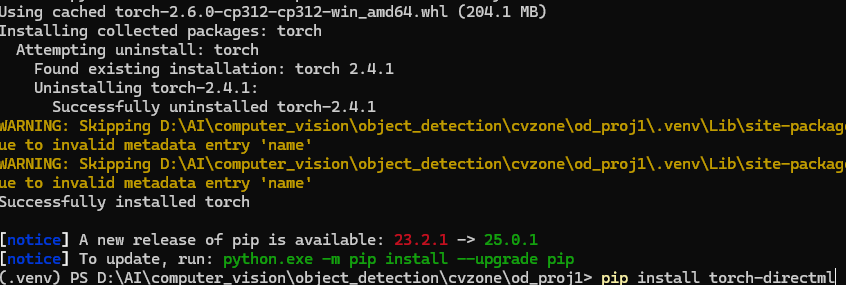
pip install torch-directml
Add this to code to test GPU
import torch_directml
device = torch_directml.device()
model.to(device)
# the above code should be before we call the modelfrom ultralytics import YOLO
import cv2
import math
import time
import torch_directml
cap = cv2.VideoCapture("../motorbikes-1.mp4") # For Video
win_name = "Motorbikes-1"
# Add this to use local AMD Radeon GPU
device = torch_directml.device()
model.to(device)
model = YOLO("../Yolo-Weights/yolov8l.pt")
# List of Class names
classNames = ["person", "bicycle", "car", "motorbike", "aeroplane", "bus", "train", "truck", "boat",
"traffic light", "fire hydrant", "stop sign", "parking meter", "bench", "bird", "cat",
"dog", "horse", "sheep", "cow", "elephant", "bear", "zebra", "giraffe", "backpack", "umbrella",
"handbag", "tie", "suitcase", "frisbee", "skis", "snowboard", "sports ball", "kite", "baseball bat",
"baseball glove", "skateboard", "surfboard", "tennis racket", "bottle", "wine glass", "cup",
"fork", "knife", "spoon", "bowl", "banana", "apple", "sandwich", "orange", "broccoli",
"carrot", "hot dog", "pizza", "donut", "cake", "chair", "sofa", "pottedplant", "bed",
"diningtable", "toilet", "tvmonitor", "laptop", "mouse", "remote", "keyboard", "cell phone",
"microwave", "oven", "toaster", "sink", "refrigerator", "book", "clock", "vase", "scissors",
"teddy bear", "hair drier", "toothbrush"
]
while cap.isOpened():
#Read frame from video
success, frame = cap.read()
if success: #if frame is read successfully set the results of the model on the frame
results = model(frame, stream=True)
# Insert Box Extraction section here
for r in results:
boxes = r.boxes
for box in boxes:
x1,y1,x2,y2 = box.xyxy[0]
x1,y1,x2,y2 = int(x1),int(y1),int(x2),int(y2) # convert values to integers
cv2.rectangle(frame, (x1,y1), (x2,y2), (0,255,0), 3)
# we can also use a function from cvzone/utils.py called
#cvzone.cornerRect(img,(x1,y1,w,h))
# extract the confidence level
conf = math.ceil(box.conf[0]*100)/100
# extract class ID
cls = int(box.cls[0])
# display both conf & class ID on frame
putTextRect(frame,f'{conf} {classNames[cls]}',(max(0,x1), max(35,y1)))
# To edit the size & thickness of text use
#putTextRect(frame,f'{classNames[cls]} {conf}',(max(0, x1),max(35,y1)), scale = 2, thickness=1)
cv2.imshow(win_name, frame)
if cv2.waitKey(1) == 27:
break # if user breaks with ESC key
else:
break # if end of video is reached
# Release video capture object and close display window
cap.release()
cv2.destroyAllWindows()0: 352x640 4 persons, 8 cars, 3 motorcycles, 1 bus, 387.5ms
Speed: 2.9ms preprocess, 387.5ms inference, 2.0ms postprocess per image at shape (1, 3, 352, 640)
0: 352x640 4 persons, 7 cars, 3 motorcycles, 1 bus, 383.2ms
Speed: 2.1ms preprocess, 383.2ms inference, 0.0ms postprocess per image at shape (1, 3, 352, 640)
0: 352x640 3 persons, 7 cars, 3 motorcycles, 1 bus, 1 truck, 373.6ms
Speed: 2.0ms preprocess, 373.6ms inference, 2.0ms postprocess per image at shape (1, 3, 352, 640)
0: 352x640 3 persons, 7 cars, 3 motorcycles, 1 bus, 1 truck, 368.1ms
Speed: 3.0ms preprocess, 368.1ms inference, 2.0ms postprocess per image at shape (1, 3, 352, 640)
0: 352x640 3 persons, 7 cars, 3 motorcycles, 1 bus, 1 truck, 340.1ms
Speed: 3.0ms preprocess, 340.1ms inference, 0.0ms postprocess per image at shape (1, 3, 352, 640)
0: 352x640 3 persons, 7 cars, 3 motorcycles, 1 bus, 1 truck, 332.1ms
Speed: 0.0ms preprocess, 332.1ms inference, 0.0ms postprocess per image at shape (1, 3, 352, 640)
0: 352x640 4 persons, 7 cars, 3 motorcycles, 1 bus, 1 truck, 412.7ms
Speed: 2.0ms preprocess, 412.7ms inference, 1.0ms postprocess per image at shape (1, 3, 352, 640)
0: 352x640 3 persons, 8 cars, 3 motorcycles, 1 bus, 2 trucks, 344.4ms
Speed: 1.9ms preprocess, 344.4ms inference, 1.7ms postprocess per image at shape (1, 3, 352, 640)
0: 352x640 3 persons, 8 cars, 3 motorcycles, 1 bus, 2 trucks, 381.1ms
Speed: 2.2ms preprocess, 381.1ms inference, 1.0ms postprocess per image at shape (1, 3, 352, 640)
0: 352x640 4 persons, 8 cars, 3 motorcycles, 1 bus, 1 truck, 353.3ms
Speed: 0.7ms preprocess, 353.3ms inference, 1.2ms postprocess per image at shape (1, 3, 352, 640)
0: 352x640 4 persons, 7 cars, 3 motorcycles, 1 bus, 359.9ms
Speed: 3.9ms preprocess, 359.9ms inference, 0.0ms postprocess per image at shape (1, 3, 352, 640)Onnx & GPU
This is using onnixruntime-directml which was slower than CPU - my guess is the GPU is not suited for ML
cap = cv2.VideoCapture("../motorbikes-1.mp4") # For Video
win_name = "Motorbikes-1"
model = YOLO("../Yolo-Weights/yolov8l.pt")
# Add this to use local AMD Radeon GPU
model.export(format="onnx")
# List of Class names
classNames = ["person", "bicycle", "car", "motorbike", "aeroplane", "bus", "train", "truck", "boat",
"traffic light", "fire hydrant", "stop sign", "parking meter", "bench", "bird", "cat",
"dog", "horse", "sheep", "cow", "elephant", "bear", "zebra", "giraffe", "backpack", "umbrella",
"handbag", "tie", "suitcase", "frisbee", "skis", "snowboard", "sports ball", "kite", "baseball bat",
"baseball glove", "skateboard", "surfboard", "tennis racket", "bottle", "wine glass", "cup",
"fork", "knife", "spoon", "bowl", "banana", "apple", "sandwich", "orange", "broccoli",
"carrot", "hot dog", "pizza", "donut", "cake", "chair", "sofa", "pottedplant", "bed",
"diningtable", "toilet", "tvmonitor", "laptop", "mouse", "remote", "keyboard", "cell phone",
"microwave", "oven", "toaster", "sink", "refrigerator", "book", "clock", "vase", "scissors",
"teddy bear", "hair drier", "toothbrush"
]
while cap.isOpened():
#Read frame from video
success, frame = cap.read()
if success: #if frame is read successfully set the results of the model on the frame
results = model(frame, stream=True)
# Insert Box Extraction section here
for r in results:
boxes = r.boxes
for box in boxes:
x1,y1,x2,y2 = box.xyxy[0]
x1,y1,x2,y2 = int(x1),int(y1),int(x2),int(y2) # convert values to integers
cv2.rectangle(frame, (x1,y1), (x2,y2), (0,255,0), 3)
# we can also use a function from cvzone/utils.py called
#cvzone.cornerRect(img,(x1,y1,w,h))
# extract the confidence level
conf = math.ceil(box.conf[0]*100)/100
# extract class ID
cls = int(box.cls[0])
# display both conf & class ID on frame
putTextRect(frame,f'{conf} {classNames[cls]}',(max(0,x1), max(35,y1)))
# To edit the size & thickness of text use
#putTextRect(frame,f'{classNames[cls]} {conf}',(max(0, x1),max(35,y1)), scale = 2, thickness=1)
cv2.imshow(win_name, frame)
if cv2.waitKey(1) == 27:
break # if user breaks with ESC key
else:
break # if end of video is reached
# Release video capture object and close display window
cap.release()
cv2.destroyAllWindows()D:\AI\computer_vision\object_detection\cvzone\od_proj1\.venv\Lib\site-packages\ultralytics\nn\tasks.py:527: FutureWarning: You are using `torch.load` with `weights_only=False` (the current default value), which uses the default pickle module implicitly. It is possible to construct malicious pickle data which will execute arbitrary code during unpickling (See https://github.com/pytorch/pytorch/blob/main/SECURITY.md#untrusted-models for more details). In a future release, the default value for `weights_only` will be flipped to `True`. This limits the functions that could be executed during unpickling. Arbitrary objects will no longer be allowed to be loaded via this mode unless they are explicitly allowlisted by the user via `torch.serialization.add_safe_globals`. We recommend you start setting `weights_only=True` for any use case where you don't have full control of the loaded file. Please open an issue on GitHub for any issues related to this experimental feature.
return torch.load(file, map_location='cpu'), file # load
Ultralytics YOLOv8.0.184 Python-3.12.9 torch-2.4.1+cu118 CPU (AMD Ryzen 5 7530U with Radeon Graphics)
YOLOv8l summary (fused): 268 layers, 43668288 parameters, 0 gradients, 165.2 GFLOPs
PyTorch: starting from '..\Yolo-Weights\yolov8l.pt' with input shape (1, 3, 640, 640) BCHW and output shape(s) (1, 84, 8400) (83.7 MB)
ONNX: starting export with onnx 1.17.0 opset 19...
ONNX: export success 3.8s, saved as '..\Yolo-Weights\yolov8l.onnx' (166.8 MB)
Export complete (10.9s)
Results saved to D:\AI\computer_vision\object_detection\cvzone\Yolo-Weights
Predict: yolo predict task=detect model=..\Yolo-Weights\yolov8l.onnx imgsz=640
Validate: yolo val task=detect model=..\Yolo-Weights\yolov8l.onnx imgsz=640 data=coco.yaml
Visualize: https://netron.app
0: 352x640 4 persons, 8 cars, 3 motorcycles, 1 bus, 413.8ms
Speed: 8.1ms preprocess, 413.8ms inference, 1.0ms postprocess per image at shape (1, 3, 352, 640)
0: 352x640 4 persons, 7 cars, 3 motorcycles, 1 bus, 439.3ms
Speed: 2.1ms preprocess, 439.3ms inference, 1.0ms postprocess per image at shape (1, 3, 352, 640)
0: 352x640 3 persons, 7 cars, 3 motorcycles, 1 bus, 1 truck, 429.1ms
Speed: 2.5ms preprocess, 429.1ms inference, 0.0ms postprocess per image at shape (1, 3, 352, 640)
0: 352x640 3 persons, 7 cars, 3 motorcycles, 1 bus, 1 truck, 390.1ms
Speed: 3.1ms preprocess, 390.1ms inference, 2.0ms postprocess per image at shape (1, 3, 352, 640)
0: 352x640 3 persons, 7 cars, 3 motorcycles, 1 bus, 1 truck, 374.5ms
Speed: 0.0ms preprocess, 374.5ms inference, 2.0ms postprocess per image at shape (1, 3, 352, 640)AMD - Linux
Check Ubuntu version
~$ lsb_release -a
No LSB modules are available.
Distributor ID: Ubuntu
Description: Ubuntu 22.04.5 LTS
Release: 22.04
Codename: jammyUpdate OS
sudo apt-get update
sudo apt-get dist-upgradeInstall AMD driver package
wget https://repo.radeon.com/amdgpu-install/6.2.3/ubuntu/jammy/amdgpu-install_6.2.60203-1_all.deb
sudo apt install ./amdgpu-install_6.2.60203-1_all.debDisplay usecase
sudo amdgpu-install --list-usecaseInstall Open source graphics and ROCm
amdgpu-install -y --usecase=wsl,rocm --no-dkmsCheck GPU is listed
$ rocminfo
WSL environment detected. ROCR: unsupported GPU